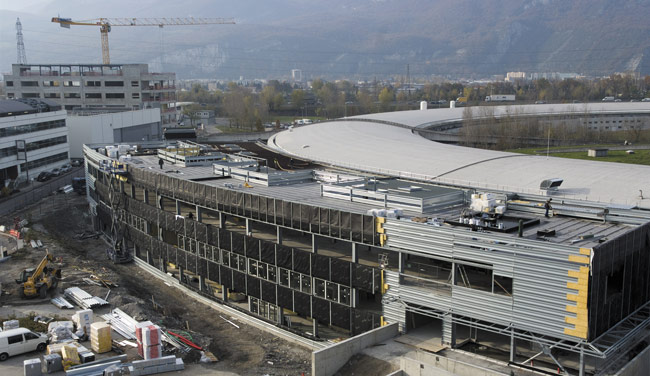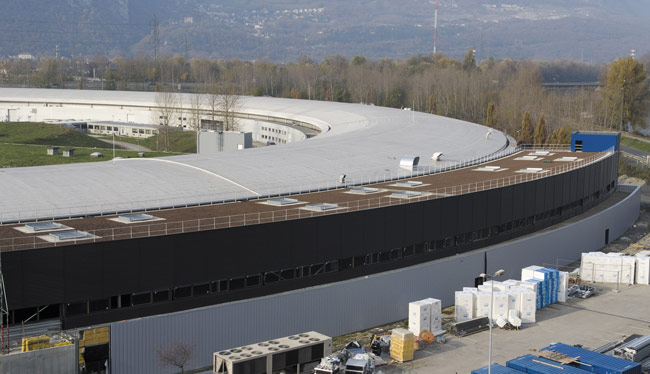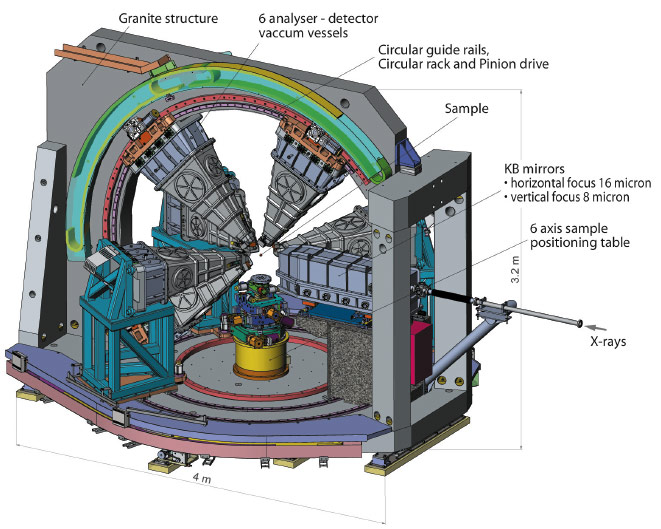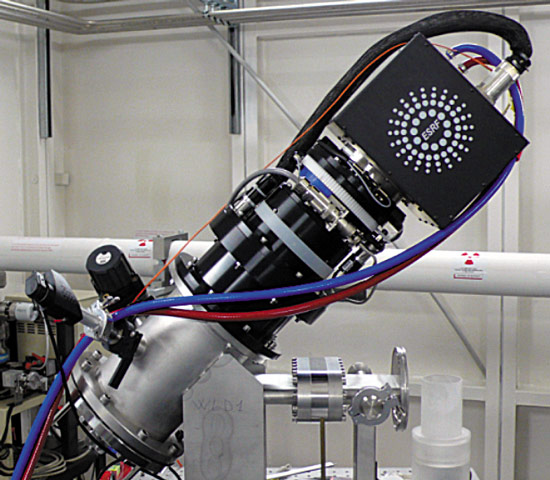- Home
- Users & Science
- Scientific Documentation
- ESRF Highlights
- ESRF Highlights 2012
- Status of the Upgrade Programme
Status of the Upgrade Programme
As the most visible part of the Upgrade Programme, the new buildings for the EX2 project are taking shape and have started to dominate the new landscape of the ESRF. The unique opportunity provided by the long shutdown in the first half of 2012 has been used for the renewal and installation of many systems and components that could not have been easily upgraded or replaced during regular shutdown periods. The facility came back into full operation in May, returning almost instantly to the high performance our users expect. The upgrade of the accelerator complex as well as the renewal of the beamline portfolio continues to be on track and in line with the master plan laid out in 2009. With the continued support from our funding bodies, we are confident to deliver the Upgrade Programme in its totality.
The EX2 project
In 2005, the first scenario of the EX2 project envisaged the creation of as many long beamlines as possible, with added laboratory and office space, and without shutdown of the facility. The constraints were already known: site topological features, continuing operation of the existing site and, most of all, extremely stringent thermal and vibration requisites well beyond those generally found in the building industry.
To address these key issues and to satisfy urban planning restrictions, a sustainable quality environment programme was incorporated into the design phase. This included measures to economise energy such as controlled air flow and the use of green roofs to boost the thermal stability of the buildings, the use of natural light to ensure the comfort of future users, building accessibility and a judicious choice of materials.
The construction project should reach completion within the next three or four months. The current advancement of the project has enabled us to measure the constraints related to the targets, and we are pleased to report that the milestones set for 2012 have all been achieved. Major works impacting the accelerator complex and the beamlines were completed as scheduled which permitted the machine restart that went ahead as planned on 19 April 2012. Most of the works on premises impacted by the project in the existing buildings are now complete. New buildings include the ID16 satellite building, which was accepted on 10 October. Since then, the first results of thermal and vibration stability of the satellite building confirm the validity of the technical design choices. Core and shell works on the new Belledonne and Chartreuse experimental halls are complete (Figure 1 and Figure 2) and work is underway to render the air treatment units operational before the “high quality slab” is poured, thus allowing the thermal effects on the cement to be controlled during the drying period.
|
Fig. 1: The Laboratory and Office Building (LOB) in front of the EX2 Belledonne extension. In the background to the left, the ILL/ESRF Science Building is also under construction. The picture was taken on 23 November 2012. |
|
Fig. 2: The EX2 Chartreuse hall. The picture was taken on 23 November 2012. |
Targets for 2013 span the completion of the technical work packages, the pouring of the high quality slabs and acceptance of installations and buildings. The final stage will be to check compatibility with specifications and to close the contracts (financial and contractual matters).
Needless to say, the stakes are high and we are confident that the project will come to fruition on time, within budget and fit for purpose thanks to the unfailing support of all those involved. Pulling the strings to coordinate a project of this scope is no mean feat. For the project manager, E. Bruas, “Management of this project will remain an impressive venture rich in human interactions. From the outset, with the identification of needs and throughout the design and construction phases, it was necessary to seek out, control and process information and strike a fine balance between technical compromises and financial and timescale constraints. The success of the trio quality, budget and timescale will be in great part due to the mobilisation of the ESRF experts whose skills allowed the design and building contractors to be guided.”
The time span of the project covers four years, starting with the architectural design competition and ending with the acceptance of the buildings. Over such a period there were many differences in interest, human resource movements, budget cuts and, inevitably, technical hitches. Project management tools, notably a collegial risk management system (technical, timescale and financial) were implemented to anticipate problems, analyse them and, whenever possible, turn them into opportunities. A good example of this was when an international panel of experts was set up to study the risk relating to the delivery of the high quality slab to required specifications. The expert advice given by this panel throughout the design phase meant the ESRF was able to benefit from experience gained in the construction of recent synchrotron facilities including ALBA, PETRA, SOLEIL and DIAMOND.
Upgrade of the source
The upgrade of the accelerator system is progressing well and as planned. An improved orbit stabilisation system – the Fast Orbit Correction – was put into service during the May restart. Users will benefit from a beam stability better than 100 nm, effectively damping the disturbances due to insertion device gap changes and magnet vibrations.
The extension of the ID23 straight section to 7 metres is in progress. This change in magnet configuration has the consequence of breaking the symmetry of the lattice, however, this will allow tests of low βy optics and new RF HOM-damped cavities. The installation of in-house designed permanent magnet steerers on ID16 brings this beamline one step closer to the canted configuration that will enable the two end stations - nano-imaging and nano-analysis - to operate in parallel.
Four solid state amplifiers now power the booster RF system. Compared to the klystron transmitter, the new system uses about one third of the power that was required previously.
A technical design study has been launched for the upgrade of the existing storage ring to increase the brilliance by more than a factor of 30, through the implementation of a 7-bend achromat lattice.
Renewal of beamlines
The Instrumentation Services and Development Division (ISDD) and the Experiments Division (ExpD) continue to be intimately involved in all upgrade beamline (UPBL) projects throughout their design, implementation and commissioning phases. In general terms, ISDD provides resources and expertise during the implementation of the Upgrade Programme for both the Experiments Division and the Accelerator and Source Division (ASD). Finding a fair balance between regular operation and new projects is still the most challenging aspect of resource monitoring. Special efforts to deploy new practices have been pursued, with particular focus given to project management in order to facilitate accurate resource allocation and monitoring. In 2012, more than 200 projects were carefully monitored.
|
Fig. 3: UPBL6 - X-ray Raman spectrometer / 4 m x 3.2 m. |
The main projects for beamline renewal are as follows:
- UPBL1 – Diffraction for nano-analysis. The TDR has been completed. The general architecture of the beamline has been finalised and the main design solutions for most major components have been selected. The detailed design of the mirrors and multilayer devices is underway.
- UPBL4 – Nano-imaging and nano-analysis. The assembly of the nano-analysis double mirror is in progress. Components for slits and attenuators and for the nano-imaging multilayer mirror have been delivered. For the nano-imaging nanotomography endstation, the sample stage based on a piezo hexapod with capacitive metrology is in the assembly phase. First lab tests were done in October 2012. The design of the large motion sample stages is being finalised
- UPBL6 – Hard X-ray spectroscopy (RIXS & XRS). The mechanical parts for the assembly of the white beam and focussing mirrors have been received and assembly is underway. The modified pre-monochromator has been successfully tested at ID20. Lab tests demonstrated 100 nrad resolution with the commercial high precision stages of the high resolution post-monochromator. The mechanical parts are being assembled. For the assembly of the RIXS and Raman spectrometers (Figure 3), the first carbon fibre chamber has been tested successfully. Acceptance tests of large positioning stages and of large granite structures are underway.
- UPBL7 – Soft X-ray spectroscopy (RIXS & XMCD). The parts required for the white beam double mirror, deflecting mirror and refocussing optics have been delivered, or are soon to be delivered, and assembly has been scheduled. The design of the entrance and exit slits is complete. Calculations to optimise the vibration stability of the RIXS spectrometer (11 m arm, integrating a collimating mirror and a grating monochromator) have been completed. The detailed design and drawings of most sub assemblies is underway.
- UPBL9A – Time-resolved ultra-small-angle scattering. Components for beamline optics have been received. The SAXS detector vacuum tube (2 m diameter, 32 m long) and internal long translation mechanism have been ordered.
- UPBL10-ID30 – Automated crystallographic evaluation. Promising first results have been obtained for the beam splitters and silicon side bounce monochromator. The optics for the three ID30A branch lines for macromolecular crystallography have been commissioned. Heat-load tests await completion. LN2 large sample dewars have been delivered and will be tested soon.
- UPBL11 – Time-resolved and extreme conditions X-ray absorption spectroscopy. EDXAS / S and L branches have accepted their first user experiments. Instrumentation was shown to be reliable and easy to use. Development has started on a Laue polychromator and pulsed magnetic fields. Other items include the installation and commissioning of a new FReLoN detector equipped with custom optics, the collaborative development and testing of a new version of the XH germanium microstrip detector from the STFC and the integration and initial tests of a linear Hamamatsu CCD sensor for energy-dispersive XAS (Figure 4).
- ID10 refurbishment. The main stage of the ID10 refurbishment was successfully completed and the beamline is back to full user operation. The white beam double mirror has been installed and awaits commissioning.
- ID19 refurbishment. The first step of the ID19 refurbishment has been successfully completed. The second stage has started with the design for the secondary source.
|
Fig. 4: UPBL11 - New back-thinned Hamamatsu CCD / 13.7 bits @ 10 Mhz, 4200 fps. |
The most noteworthy activities of the ISDD in 2012 included the procurement of 44 X-ray mirrors – from tender exercises to qualification testing and final installation, the delivery of several customised X-ray detectors and the design of highly-complex large-structure scientific instruments. Furthermore, the long shutdown provided the opportunity to put into operation several upgraded software packages and to deploy new generic solutions over our entire beamline portfolio. This included the upgrade of the beamline vacuum control and insertion device control on most of the beamlines, the production of standard beam viewers for twelve beamlines, the tender procedure for a large volume order of IcePAP motor controllers, the design and production of new electronic modules for beamline control such as new V2F100 voltage-to-frequency converters, the final commissioning of the fast orbit feedback for the storage ring, continuation of beamline control modernisation (vacuum and insertion device controls), the implementation of new online data analysis algorithms (MX auto-processing and spectro-imaging) and special projects in parallelisation of modelling and data analysis software packages as well as the upgrade of the Debian operating system and the batch systems (OAR). Despite the very high workload on the UPBLs, a number of R&D programmes have made good progress. A few examples are: MEDIPIX3-based modules, APD-based 2D detector XNAP and a new scintillator material, development of a silicon-to-glass bonding machine for mass fabrication of high resolution X-ray spherical analysers and a new hexapod support for mirror positioning.
B. Dijkstra, R. Dimper, H. Reichert, P. Raimondi and J. Susini







